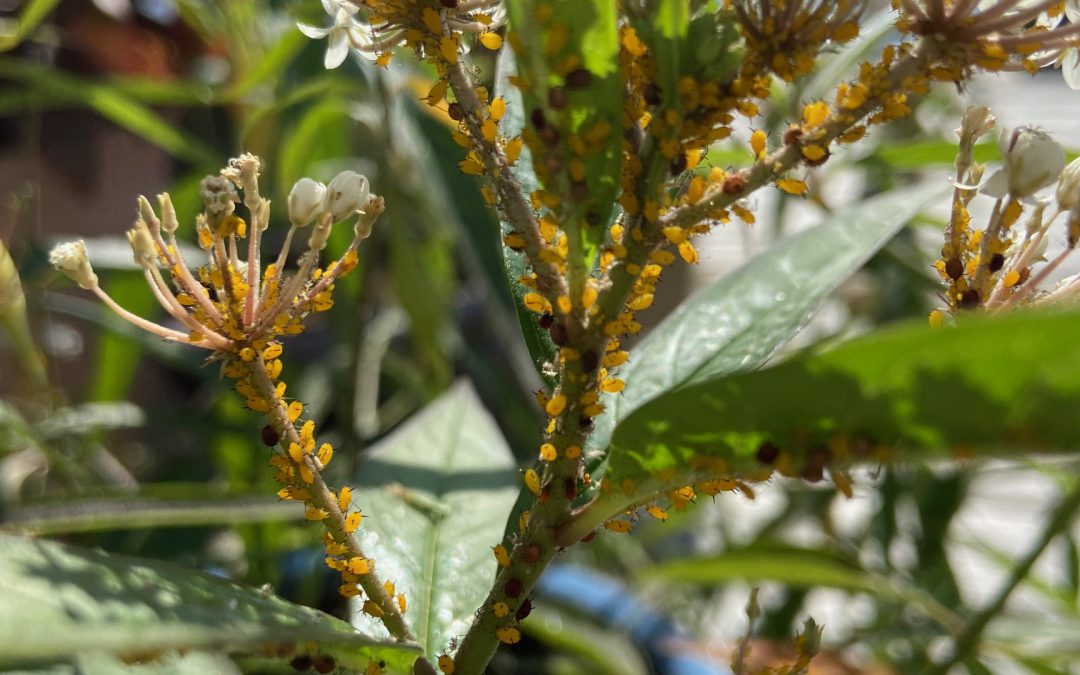
by Mary Salinas | Sep 8, 2020

Perennial milkweed, Asclepias perennis, with oleander aphids; notice the brown aphid mummies that have been parasitized. Photo credit: Mary Salinas UF/IFAS Extension.
Milkweeds are appreciated for their beauty, but often we cultivate it for the benefit of the monarch butterflies who lay their eggs only on this plant genus. Avid butterfly gardeners want the monarch caterpillars to eat up the milkweed and become beautiful butterflies. Often instead, thousands of aphids show up and compete for space on the plants. These bright yellow aphids are known as oleander aphids.
Just how do aphids build up their populations so quickly? It seems that one day you have a small number on a few plants and then a few days later, thousands are all over your milkweed. Oleander aphids have a few advantages for quickly building their populations:
- All oleander aphids are female and do not need to mate to produce their young
- Aphids give birth to live young who immediately start feeding on the plant
- Aphids start reproducing when they are 4 to 10 days old and keep reproducing during their one-month life span
- When populations get heavy or the plant starts to decline, winged individuals are produced to migrate to new areas and plants.
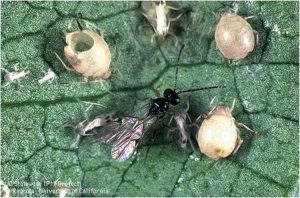
Parasitic wasp and aphid mummies. Photo credit: University of California.
What can or should you do to control this pest?
One option is to do nothing and let the natural enemies come in and do their job. One of the best is a very tiny wasp that you will likely never see. This parasitoid lays its eggs only inside aphids. The wasp larva feeds on the inside of the aphid and turns it into a round brown ‘mummy’ and then emerges when mature by making a round hole in the top of the aphid. Look closely with a hand lens at some of those brown aphids on your milkweed and you can see this amazing process. Another common predator I see in my own garden is the larvae of the hover fly or syrphid fly. You will have to look hard to see it, but it is usually there. Assassin bugs and lady beetles also commonly feed on aphids. The larvae of lady beetles look nothing like the adults but also are voracious predators of aphids – check out what they look like.
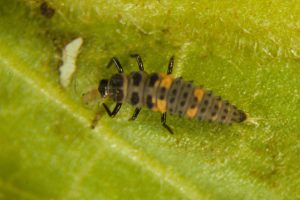
Lady beetle larva feeding on aphid on tobacco. Photo credit:
Lenny Wells University of Georgia Bugwood.org.
If you think your situation requires some sort of intervention to control the aphids, first check carefully for monarch eggs and caterpillars, keeping in mind that some may be very small. Remove them, shoo away any beneficial insects, and spray the plant completely with an insecticidal soap product. Recipes that call for dish detergents may harm the waxy coating on the leaves and should be avoided. The solution must contact the insect to kill it. Always follow the label instructions. Soap will also kill the natural enemies if they are contacted. One exception is the developing wasp in the aphid mummies – fortunately, they are protected inside as the soap does not penetrate. Oils derived from plants or petroleum can serve the same purpose as the insecticidal soap.

Syrphid fly larva and oleander aphids. Photo credit: Lyle Buss, University of Florida.
You also can squish the aphids with your fingers and then rinse them off the plant. If you only rinse them off, the little pests can often just crawl back onto the plant.
There are systemic insecticides, like neonicotinoids, that are taken up by plant roots and kill aphids when they start feeding on the plants. However, those products also kill monarch caterpillars munching on the plant and harm adult butterflies, bees, and other pollinators feeding on the nectar. So those products are not an option. Always read the product label as many pesticides are prohibited by law from being applied to blooming plants as pollinators can be harmed.
In the end, consider tolerating some aphids and avoid insecticide use in landscape.
Happy butterfly gardening!

by Larry Williams | Aug 14, 2020
Oleander caterpillars, which are active on some oleanders during summer, can provide a number of gardening lessons.
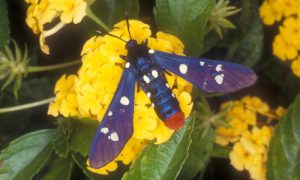
Oleander caterpillar moth on lantana flower. Photo credit: James Castner, UF
The adult moth is striking in appearance. The bluish to purplish moth has white dots on its black wings. The moths resemble wasps as they fly in and around oleander shrubs.
It’s the orange caterpillars with black spots and black hairs that cause problems for some gardeners.
Caterpillars are the larval stage of butterflies and moths. In order to enjoy watching butterflies and moths feeding on the nectar of flowers, some of the caterpillars must survive to become adult butterflies and moths. This is lesson number one.
Oleander caterpillars usually only feed on oleander plants. Oleanders are native to areas of Europe and Asia. This is lesson number two.
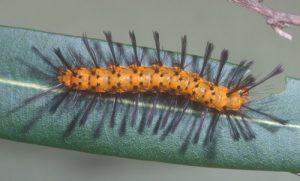
Oleander caterpillar, Photo credit: Paul Choate, UF
Oleander caterpillars benefit by us planting their food source in Florida.
This relationship between pest and plant is referred to as the key plant, key pest concept. Some other examples include St. Augustinegrass and chinch bugs, gardenias and whiteflies, crape myrtles and crape myrtle aphids, azaleas and azalea caterpillars, camellias and tea scale, roses and black spot, pecans and pecan scab, squash and squash vine borers.
Understanding this concept can be helpful in designing a “low maintenance” landscape.
When you plant roses, you plant everything that goes with roses, including the time and money required to maintain them. This applies to St. Augustinegrass, pecan trees, squash and oleanders. This is lesson number three.
Oleander caterpillars can temporarily damage the appearance of oleanders. But they cause no long-term damage for the plant. This is lesson number four. The damage is aesthetic. Oleander caterpillars can consume great numbers of leaves. However, if the plant is otherwise healthy, new leaves will be produced and the plant will continue to grow. The damage is temporary; there will be no evidence the plant ever had a problem.
To spray or not to spray for oleander caterpillars has to do with a person’s tolerance level.
If you can’t tolerate having oleander caterpillars around and the temporary aesthetic damage they cause, consider the use of Bacillus thuringiensis. It is sold under a number of brand names and many times is referred to as Bt. This bacterium only controls caterpillars so it is friendlier for the beneficial insects. When using any pesticide, always follow the label directions and precautions.
Here are links to UF/IFAS Extension publications with more info.
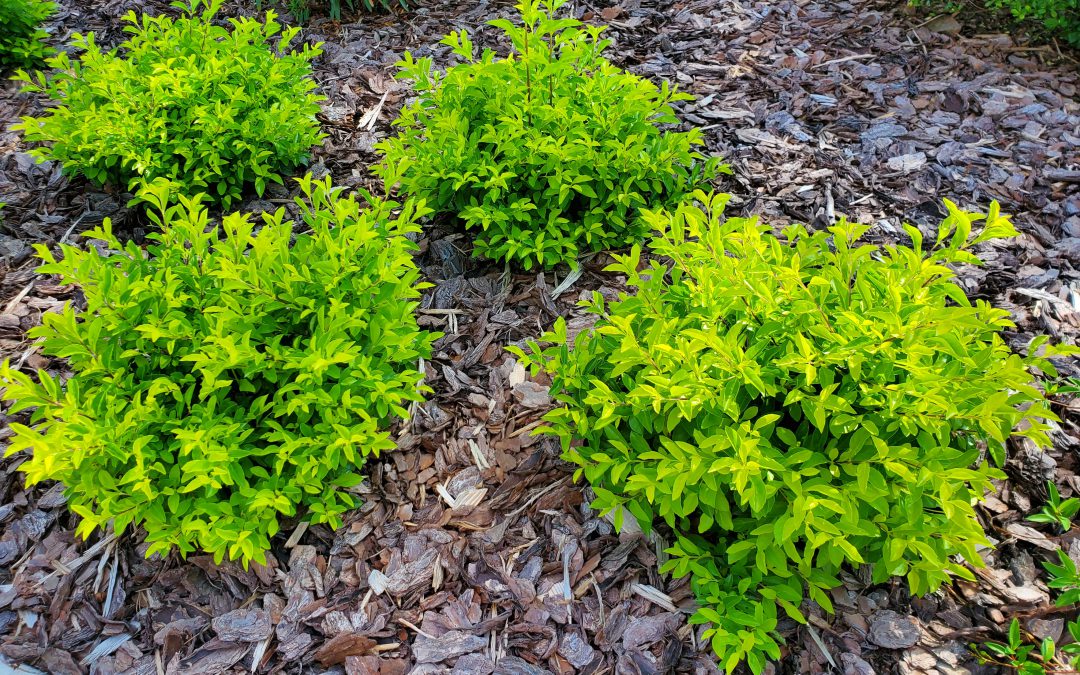
by Daniel J. Leonard | Jul 23, 2020
Flowers can often be fickle in the landscape, so, this year, I decided to add a shot of no-maintenance color to my landscape with foliage plants! The benefits of ornamentals that don’t need flowers to put on a show are many. Their water and fertility needs are often less because they don’t have to support the large energy and irrigation requirements the flowering process demands. They don’t need deadheading to look their best and they lend an awesome texture that is overlooked in many landscapes. My summertime foliage plant of choice provides all those things in a small, bright yellow package; it’s a widely sold selection of Duranta called ‘Gold Mound’.
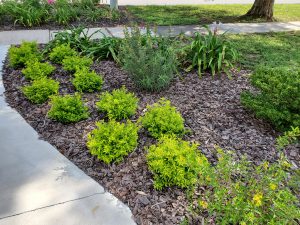
Mass of ‘Gold Mound’ Duranta in the author’s landscape.
‘Gold Mound’ Duranta is a small shrub known for its chartreuse to bright yellow foliage and generally grows 24” or so tall and wide in the Panhandle, allowing it to fit in nearly any landscape. ‘Gold Mound’ has been around in the horticulture trade a long time and is a popular perennial shrub in the southern parts of Florida. It was recognized as the Florida Nursery, Growers, and Landscape Association’s (FNGLA) plant of the year in 2005 and regularly occupies a spot in the color displays of big box and local nurseries, even in the Panhandle, however, despite these attributes, ‘Gold Mound’ is a rare find in Northwest Florida landscapes. That needs to change!
In our neck of the woods, Duranta ‘Gold Mound’ is incredibly low maintenance. I planted a grouping of thirteen specimens near the end of my driveway to provide a consistent season long splash of color to complement the fleeting blooms of the spring flowering shrubs, the drab greenery of the neighbor’s lawn and the on-again, off-again ‘Drift’ Roses they share the bed with. The result has been awesome! I watered frequently until the small shrubs were established and on their own, with no irrigation since. I fertilized at planting with a slow release, polymer coated fertilizer and have not had to help them along with subsequent applications. Even better, despite our frequent rainfall and heat/humidity, no pests or diseases have come knocking. Just because I enjoy gardening doesn’t mean I need a landscape full of divas and I can count on ‘Gold Mound’ to not need pampering.
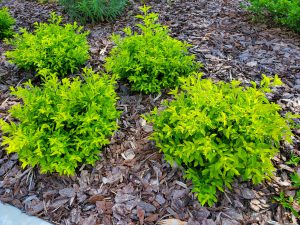
Incredible chartreuse foliage of ‘Gold Mound’.
Maybe my favorite part of ‘Gold Mound’ Duranta in the Panhandle is that it isn’t permanent. Duranta is a native of the Caribbean tropics and is not particularly cold hardy, most Northwest Florida winters knock it back hard, if not outright killing it. Therefore, ‘Gold Mound’ is best enjoyed here as an annual, planted when the weather warms in the spring, enjoyed until the first frost, then pulled up and discarded. Easy peasy. No long-term commitments required. My uncle, the chainsaw gardener, doesn’t even have to chop it back! Just compost the plants each winter or toss them in the trash, hit up your local nursery the next spring for some new plants and do it all over again. Though it has to be replanted each year, Duranta ‘Gold Mound’ won’t break the bank. The generic ‘Gold Mound’ is commonly sold in 4” containers for just a few dollars apiece in the annual section of plant nurseries, making it a very affordable option, especially compared to some of the new, designer perennials it competes with.
Though some landscape designers recommend just using a single specimen of ‘Gold Mound’ here and there for small pops of color, I prefer using groupings of the plant. I’ve seen successful plantings of ‘Gold Mound’ massed in large groups to create annual color beds at key points in landscapes and also planted across the front of a bed to complement darker foliaged backdrop or foundation plants, such as Boxwood or Loropetalum. Regardless of how you decide to use them in your yard, I don’t think you can go wrong with adding some color pizazz to your landscape with the inexpensive, low-maintenance, Florida-Friendly plant, ‘Gold Mound’ Duranta. Happy gardening!

by Stephen Greer | Jul 16, 2020
By: Stephen Greer, CED Santa Rosa County
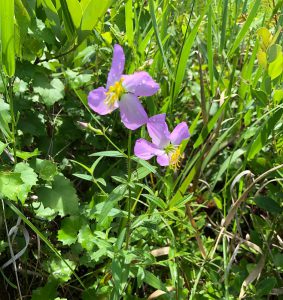
Rhexia marianna Photo credit: Stephen Greer, University of Florid IFAS
There is a lot to be said about early morning or late afternoon walks along a woodland trail in Northwest Florida. With so much to see, hear and smell there is never enough time to take it all in. I would suggest slowing down and look for the many colorful and interesting plants these native plant communities have to offer.
I had the great fortune to meet with a group of plant explores lead by Angus Gholson, botanist and conservationist with a passion to share his knowledge in Washington County many years ago for a 5-hour hiking adventure. We hiked an exceptional longleaf pine forest with immense flora on the forest floor. It was all but impossible to see everything.
We searched for unique and common plants in the Sandhills and Clayhills in the central and northern areas of Washington County. Here are just a few of the plants we saw along our hike and some detail about them.
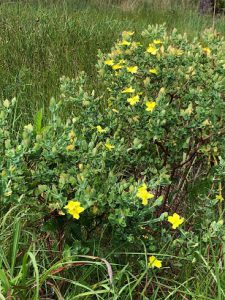
St. Peter’s-wort. Photo create: Stephen Greer University of Florida IFAS
St. Peter’s-wort, Hypericum tetapetalum is a wonderful Hypericum of the many we have in NW Florida. With its ability to repeat bloom petite yellow flowers from March to November, we often get the chance to revisit these trails at a later date for another chance to enjoy them. Like many repeat blooming natives, there will be weeks of rest periods with no bloom. This shrub will grow to three feet tall allowing the flowers to peak out over other plants in the pine flatwoods.
Shiny Lyonia, Lyonia lucida is another exceptional shrub with many uses. This evergreen can grow in low damp areas or with irrigation in landscapes to 10 to 12 feet tall. When found in pine forest areas they range from 3 – 6 feet tall. This Lyonia produces an attractive small bell-shaped red flower spread across a stem of last years growth similar to blueberry. Flowering can occur between November and June.
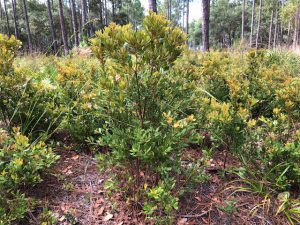
Lyonia lucida. Photo credit: Stephen Greer, University of Florid IFAS
Pale Meadow Beauty, Rhexia Marianna brings a soft pink bloom to the pine forest, grass prairies and edge of full sun to part-shade wetlands. With the ability to grow in diverse landscapes in Northwest Florida it can just about show up anywhere, bloom a few weeks and melt back into the natural setting. Seeding is best completed in the fall and consistent moisture is needed for bloom to occur.
All three of the plants in this article can be found at native plant nurseries. Call the nursery well ahead of time to make sure they either have it or can order it for you. Enjoy the outdoors and adventure it has to offer.

by Julie McConnell | Jul 16, 2020
We hope you were able to join us for Gardening in the Panhandle LIVE! Butterfly Gardening on July 9th to learn about attracting butterflies to your Florida gardens. As promised, we have compiled a list of butterfly resources that we talked about during the webinar and a few extra that we didn’t have time to cover.
If you were not able to join us live, you can still watch the videos on Facebook or YouTube
Click on the topic of interest for links to resources:
Don’t forget to tune in for our next Gardening in the Panhandle LIVE! on July 23rd for Prepping for the Fall Garden. Register for that webinar on Zoom or Follow our Facebook Event for updates.
For a full list of upcoming webinars visit Gardening in the Panhandle: LIVE!

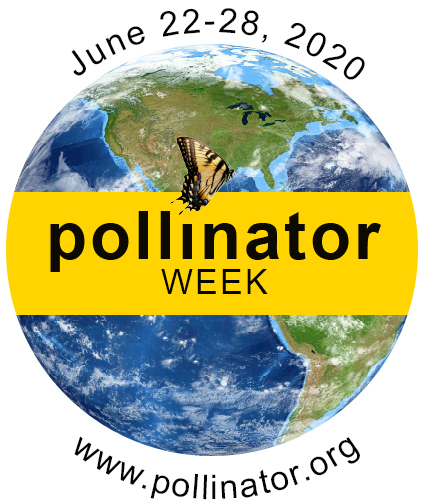
by Mary Salinas | Jun 23, 2020
For the 13th year we celebrate National Pollinator Week June 22-28 to bring awareness to the importance of our pollinators and the challenges they face. This is an opportunity to learn about ways to protect pollinators in our own landscapes. Every one of us can make a difference.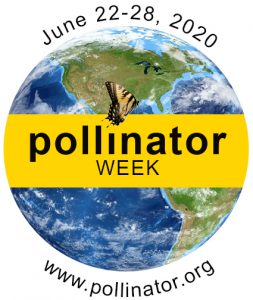
When we hear the word ‘pollinator’ most of us immediately think of honeybees. They are very important but there are so many other creatures that are important pollinators:
- Native bees – Florida alone has over 300 species of bees
- Hummingbirds – their long beaks can reach into long, tubular blooms
- Bats – they pollinate over 500 plants including banana, mango, and agave (used to make tequila)
- Beetles – considered to be a messy and minor pollinator; they pollinate the native paw paw
- Butterflies – a minor pollinator as most have long legs that keep them perched above the pollen
- Flies – pollinators of a variety of native plants
According to the USDA, 75% of flowering plants and about 35% of food crops around the globe rely on these animals for pollination. Without pollination, these plants would not reproduce or provide us food.
So, what can the average person do to make a difference?
- Plant what bees and butterflies love!
- Avoid using any insecticide unless it is absolutely necessary. Predators like assassin bugs, dragonflies and birds help to keep pests in check. Our songbirds rely on protein-rich insects (especially caterpillars) to feed their growing babies.
- Don’t treat areas where pollinators are visiting the flowers, whether in the lawn or the landscape beds.
- If you need to apply an insecticide to the lawn, mow first to remove the blooms from any weeds. Always follow the label instructions carefully.
- Avoid using a systemic insecticide on plants that bloom and attract pollinators. The insecticide can remain in plants for a long time.
Happy gardening during National Pollinator Week!
For more information:
Pollinator Partnership: Pollinator Week Activities
US Fish & Wildlife Pollinator Site
Native Insect Pollinators of the Southeastern United States brochure
Purdue University: Protecting Pollinators in Home Lawns and Landscapes
Minimizing Honey Bee Exposure to Pesticides



















